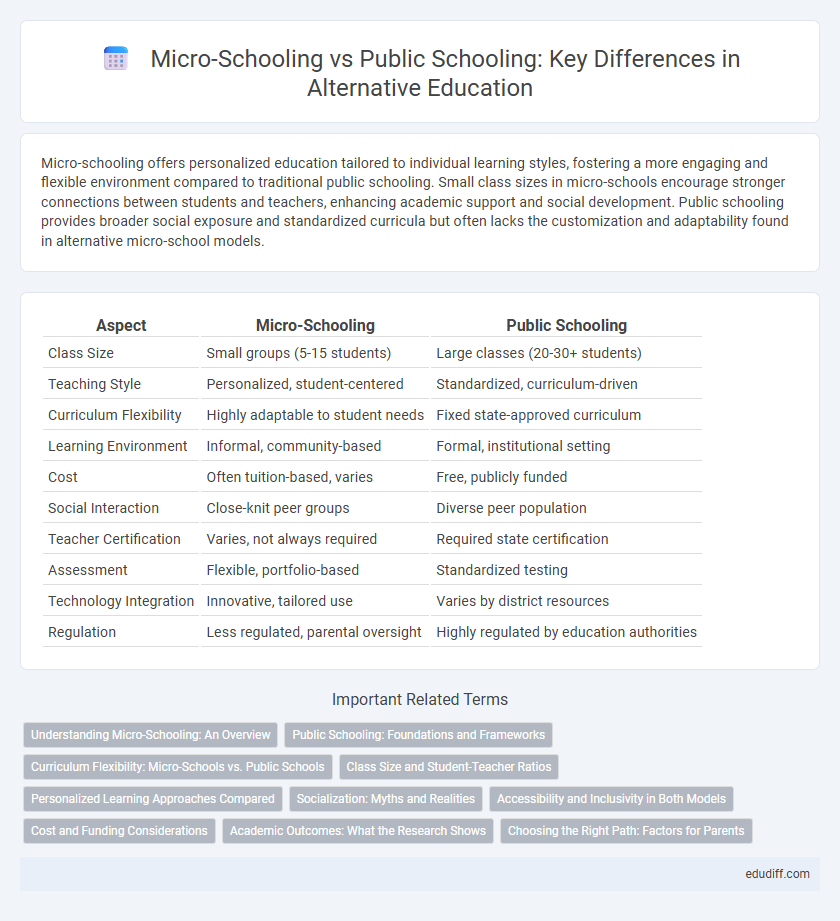Micro-schooling offers personalized education tailored to individual learning styles, fostering a more engaging and flexible environment compared to traditional public schooling. Small class sizes in micro-schools encourage stronger connections between students and teachers, enhancing academic support and social development. Public schooling provides broader social exposure and standardized curricula but often lacks the customization and adaptability found in alternative micro-school models.
Table of Comparison
| Aspect | Micro-Schooling | Public Schooling |
|---|---|---|
| Class Size | Small groups (5-15 students) | Large classes (20-30+ students) |
| Teaching Style | Personalized, student-centered | Standardized, curriculum-driven |
| Curriculum Flexibility | Highly adaptable to student needs | Fixed state-approved curriculum |
| Learning Environment | Informal, community-based | Formal, institutional setting |
| Cost | Often tuition-based, varies | Free, publicly funded |
| Social Interaction | Close-knit peer groups | Diverse peer population |
| Teacher Certification | Varies, not always required | Required state certification |
| Assessment | Flexible, portfolio-based | Standardized testing |
| Technology Integration | Innovative, tailored use | Varies by district resources |
| Regulation | Less regulated, parental oversight | Highly regulated by education authorities |
Understanding Micro-Schooling: An Overview
Micro-schooling offers a personalized education model that typically involves smaller class sizes, flexible curricula, and strong community engagement, contrasting with the standardized approach of public schooling. It emphasizes tailored learning experiences that cater to individual student interests, pace, and learning styles, often incorporating project-based and experiential learning methods. This alternative educational option fosters a close-knit environment where educators can adapt teaching strategies to optimize student growth and academic outcomes.
Public Schooling: Foundations and Frameworks
Public schooling operates within state-mandated frameworks that ensure standardized curricula, assessment methods, and accountability systems across diverse student populations. These schools are funded primarily through local, state, and federal taxes, providing free education while adhering to regulations established by education departments. The foundations of public schooling emphasize inclusivity, equity, and access, supported by certified educators and structured learning environments designed to meet academic and social development benchmarks.
Curriculum Flexibility: Micro-Schools vs. Public Schools
Micro-schools offer significantly greater curriculum flexibility compared to public schools, allowing personalized learning paths tailored to each student's strengths and interests. Public schools typically follow rigid state-mandated curricula designed to meet standardized testing requirements, limiting adaptability to individual educational needs. This increased flexibility in micro-schools fosters creativity, critical thinking, and deeper engagement by integrating interdisciplinary and project-based learning approaches.
Class Size and Student-Teacher Ratios
Micro-schooling typically features class sizes of 10 to 15 students, fostering personalized instruction and higher student engagement. Public schools often have class sizes averaging 25 to 30 students, resulting in larger student-teacher ratios that can limit individual attention. Lower student-teacher ratios in micro-schools contribute to tailored learning experiences and better academic outcomes compared to traditional public school environments.
Personalized Learning Approaches Compared
Micro-schooling offers highly personalized learning approaches by tailoring curricula to individual student interests, strengths, and pace, enabling deeper engagement and mastery. Public schooling often employs standardized curricula with limited flexibility, though some schools integrate differentiated instruction and technology-driven adaptive learning tools. Data shows micro-schools typically maintain smaller class sizes, averaging 5-15 students, compared to public schools' average of 20-30, facilitating more focused teacher-student interaction and customized support.
Socialization: Myths and Realities
Micro-schooling challenges the myth that public schools are the only environment for effective socialization by fostering close-knit communities and personalized interactions. While public schools offer diverse peer groups, micro-schools provide tailored social experiences that can enhance emotional intelligence and collaboration skills. Research shows both settings develop social competencies differently, debunking the notion that social development is uniform across educational models.
Accessibility and Inclusivity in Both Models
Micro-schooling offers tailored learning environments that accommodate diverse student needs, promoting higher accessibility for families seeking personalized education. Public schooling provides broad inclusivity through universal enrollment policies and federally mandated accommodations for students with disabilities and language barriers. Both models strive to reduce educational disparities, but micro-schools excel in flexibility while public schools ensure widespread access across socioeconomic backgrounds.
Cost and Funding Considerations
Micro-schooling often requires lower tuition fees compared to public schooling, but families typically bear more direct financial responsibility due to limited government funding. Public schools benefit from state and federal funding, reducing or eliminating out-of-pocket costs for students and providing resources for infrastructure and educational programs. Cost analysis must include expenses like materials, technology, and extracurricular activities, which can vary widely between micro-schools and public schools.
Academic Outcomes: What the Research Shows
Research indicates micro-schooling often delivers personalized learning experiences that can enhance academic outcomes through tailored curricula and small class sizes, fostering deeper engagement and mastery of subjects. Public schooling, while offering standardized curriculum and broader access to resources, shows varied academic results influenced by factors such as class size, funding, and teacher quality. Studies highlight that micro-schools tend to outperform public schools in standardized test scores and student satisfaction, particularly in settings emphasizing individualized instruction and project-based learning.
Choosing the Right Path: Factors for Parents
Parents considering micro-schooling versus public schooling should evaluate class size, personalized learning, and curriculum flexibility to match their child's needs. Micro-schools often offer tailored instruction and closer teacher-student relationships, promoting engagement and academic growth. Public schools provide diverse social environments and access to extensive resources, which are essential for social development and extracurricular opportunities.
Micro-Schooling vs Public Schooling Infographic

 edudiff.com
edudiff.com